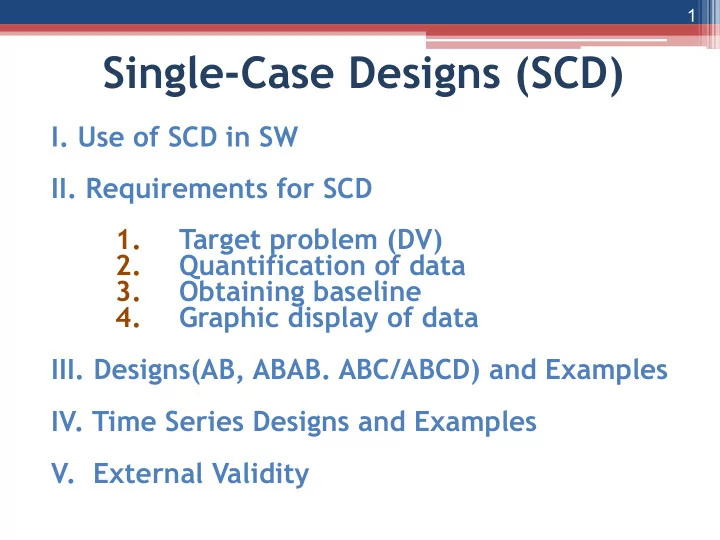

1 Single-Case Designs (SCD) I. Use of SCD in SW II. Requirements for SCD 1. Target problem (DV) 2. Quantification of data 3. Obtaining baseline 4. Graphic display of data III. Designs(AB, ABAB. ABC/ABCD) and Examples IV. Time Series Designs and Examples V. External Validity
2 I. Use of Single Case Design in SW § Logic of time-series design § Also called Single-subject/single- system design, and N=1 studies § Most relevant research topics for clinical practitioners § Major limitations: Sample Sizes are small (usually 1) and problems with external validity
3 II. Requirements for SCD 1. Target problem(s) Decide desired outcome (=DV) to be measured § Positive or negative indicator? § Should occur frequently enough § v Triangulation
4 II. Requirements for SCD 1. Target problem(s) Who will measure it? (1) self-monitoring, § (2) practitioner, (3) significant others Sources of data: (1) self-report scale, § (2) direct observation, (3) available records v Triangulation with multiple measures and observers are strongly preferred
5 II. Requirements for SCD 2. Quantification of data a) Frequency b) Duration c) Magnitude
6 II. Requirements for SCD 3. Obtaining baseline phase Repeated measures before the intervention § (=control phase) Attributes of good baseline: § 1) Minimum of 5-10 measurements 2) Stable 3) Problem is not nearing resolution before the intervention
7 Examples of Baseline Measures
8 Baseline and Intervention Phases
9 Baseline and Intervention Phases
10 II. Requirements for SCD 4. Graphic display of data X axis: § Y axis: § (dashed) Vertical line § Data points § Labels: Baseline/A phase, Intervention § phase/B phase
11 III. Designs 1. AB design § One baseline phase & one intervention phase § Advantage(s): § Disadvantage(s): § Retrospective baseline
12 III. Designs 2. ABAB design § Withdrawal/reversal design § Advantage(s): § Disadvantage(s):
13 III. Designs 2. ABAB design
14 III. Designs 3. Multiple-component designs (ABC, ABCD) § Add a third type of intervention § Caution: carryover effect, order effect, irreversibility effect, history
15 III. Designs 3. Multiple-component designs (ABC, ABCD)
16 III. Designs § Replication can enhance both internal and external validity. *Be prepared for practical obstacles*
17 IV. Time Series and Related Designs Notations: X = introduction of stimulus, intervention, or treatment O = observation/measurement 1. Time-series design O O O O O X O O O O O
18 Examples of Time Series Projects
19 V. External Validity • Generalizability • Representativeness of sample, setting and procedures • Sampling and survey research
Recommend
More recommend